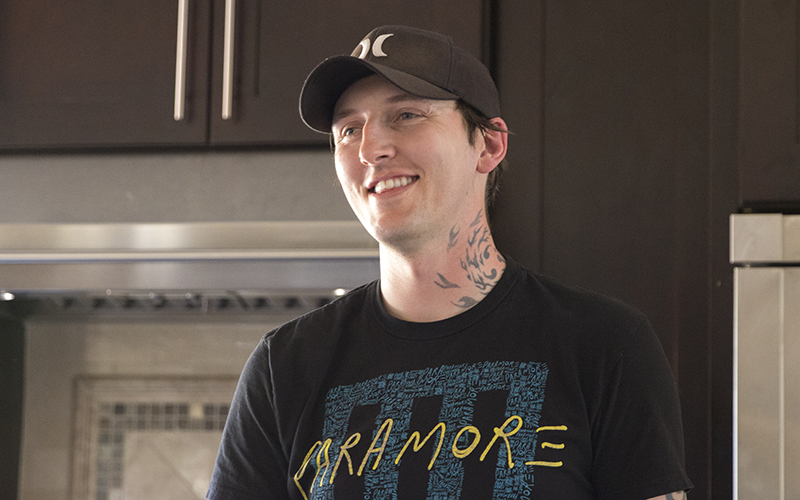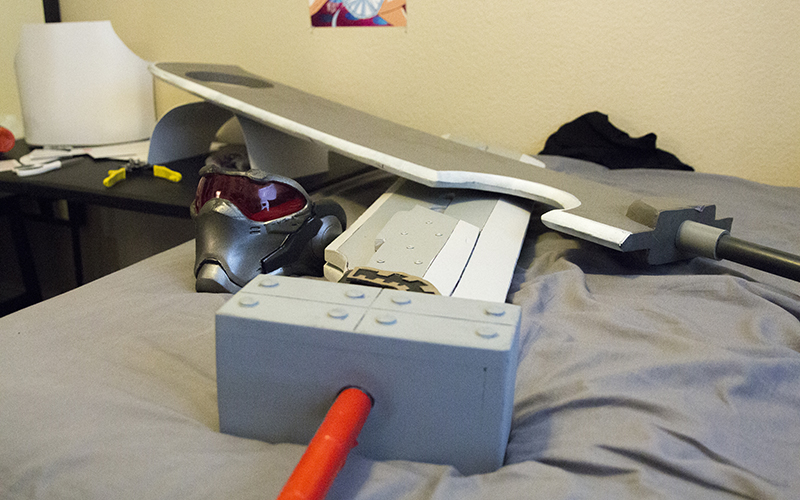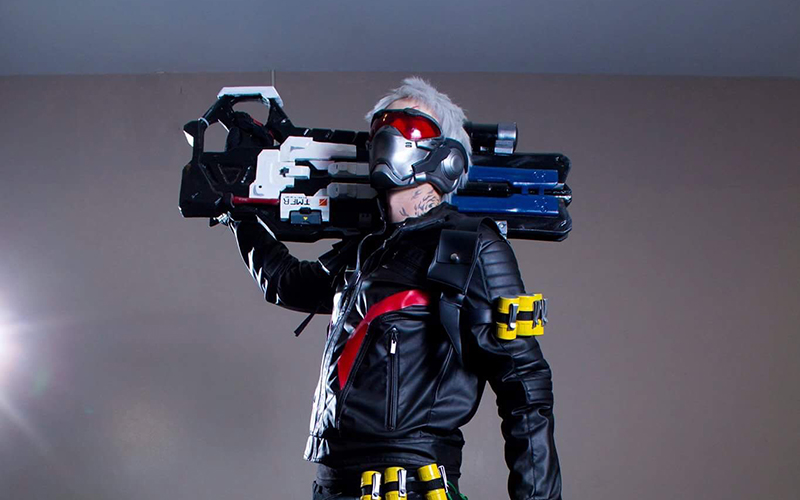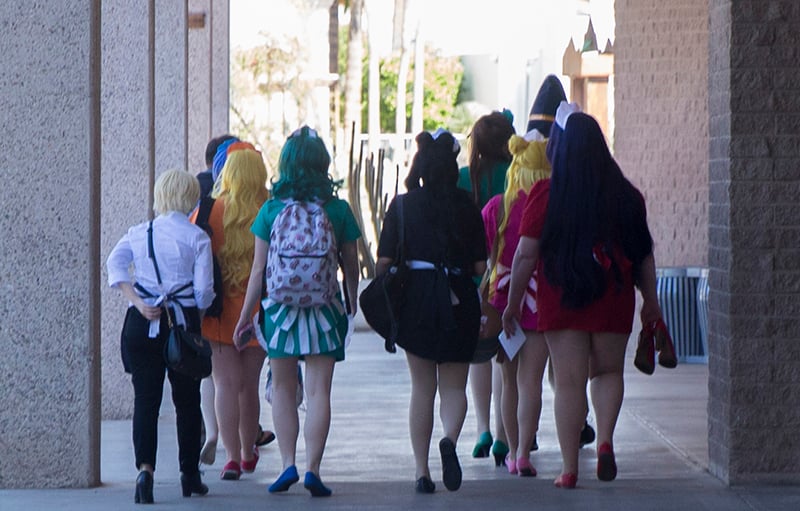
People walked down the streets in cloaks, masks, weapons and body paint to attend Con Nichiwa, an anime convention at the Tucson Convention Center held in March. (Photo by Megan Bridgeman/Cronkite News)
TUCSON – When Dustbunny first learned about cosplay in high school, she viewed it as just “dress up.”
But now, the 29-year-old Los Angeles resident considers herself a semi-professional cosplayer. She served as the special guest for Tucson’s recent Con Nichiwa anime convention, and she travels across the country to serve as a panelist and cosplay judge.
Dustbunny still has a full-time job, so she mostly does convention appearances on weekends. That hasn’t stopped her from garnering a large following.
Her Facebook page has nearly 300,000 likes, and she’s witnessed the hobby she loves dramatically leap from obscurity into the mainstream.
“Cosplay has changed so much. Let me say I have an alias for a reason,” Dustbunny said. “I thought I didn’t want employers to know because I thought they’d think it was weird. But now, cosplay is so mainstream in a sense, there (are television shows) ‘Cosplay Melee’ now and ‘Heroes of Cosplay.'”
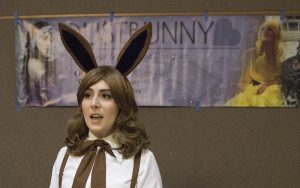
Dustbunny, a semi-professional cosplayer, runs her booth at Con Nichiwa in Tucson. (Photo by Megan Bridgeman/Cronkite News)
“Cosplay” comes from the combination of the words “costume” and “play” and involves people dressing up as characters from video games, television shows, anime, movies or books. They may decide to act in character while in costume as well, making it more of a performance art.
Arizona’s largest pop-culture convention, Phoenix Comicon, opens Thursday at the Phoenix Convention Center.
What started mainly as a hobby popular in Japan has exploded into a multibillion-dollar industry that has surged in popularity in the U.S. In Arizona, people can spend thousands of dollars on things like convention tickets, hotel stays, custom-made costumes and props.
Why such rapid growth? Cosplay offers people a chance to show off their creativity, connect with other like-minded individuals and sometimes even allows them to make a few bucks. The growing number of conventions, social media and the acceptance of fandoms have fueled the industry.
“Even my mom is now going, ‘cosplay is kind of cool,'” Dustbunny said.
Phoenix convention scene explodes
Every May, tens of thousands of people converge on downtown Phoenix for Phoenix Comicon. They often walk blocks in the scorching heat, donning plastic, leather or furry costumes and trying to keep the makeup from running down their faces.
And over the past five years, Phoenix Comicon has grown dramatically from about 23,000 attendees in 2011 to more than 106,000 attendees in 2016, representatives said.
“Over the last five years, cosplay culture has exploded dramatically, and I’m amazed by the number of attendees who dress up,” Joe Boudrie, Phoenix Comicon director of programming, said in an email. “The explosion of pop culture and costuming have created a feedback where each side is making the other grow.”
Phoenix Comicon attendees pay about $20 to $45 for a one-day ticket to listen to panels, meet celebrities, shop the exhibit floor and mingle with other attendees.
Boudrie credited the convention’s success to local groups and cosplay celebrities such as Jessica Nigri for drawing more fans and creators into the hobby.
Although Phoenix Comicon is the state’s largest fan convention, it is not the only one. Arizona now hosts about 20 pop-culture conventions every year.
Tucson Comic-Con started in 2008 with just 500 fans. Now the event has more than 10,000 attendees.
Saboten Con in Phoenix, the largest anime convention in the state, had about 2,700 attendees in 2011. Five years later, that number had grown to more than 9,000.
Cosplay revenues expected to grow
“A drug habit would be cheaper than cosplay,” joked Steve Mitchel, who has been cosplaying since the early 2000s and often dresses as Superman.
Annually, cosplayers can spend hundreds to thousands of dollars, buying materials such as fabrics, plastics, metals, wigs and makeup. Their purchases have created a massive market.
In 2014, the global market size of cosplay costumes and wigs reached revenues of about $11.7 billion and $561.5 million respectively, according to Shanghai-based research firm CRI.
Additionally, CRI analysts expect involvement in cosplay to grow, estimating that revenues will reach $23.6 billion for costumes and more than $1.1 billion for wigs by 2019.
Mitchel estimates that he spends a few thousand dollars yearly on the hobby and attends a half dozen conventions. But he also makes a bit of extra cash from the industry as well.
(Video by Charlie Clark/Cronkite News)
Fans often approach other cosplay creators to build props and costumes. For many, it proves a convenient way to supplement their income and fund their own work.
A quality builder’s rate can cost upward of $25 per hour, Mitchel said.
Some people have even turned their work into a full-time venture.
Yaya Han, one of the most popular cosplayers in the U.S., is a pioneer in this area. She not only earns money selling photos and making appearances, but she also sells props and accessories she designs.
In some cases, cosplayers also sell prints of themselves, promote products or even ask others to support their work by selling subscriptions through a Patreon account or Gofundme. These patrons pay to receive access to pictures, videos, posters and other content.
Popular Arizona cosplayer Jessica Nigri is one of the most prominent examples of this. Nigri has more than 4,200 patrons who support her on Patreon, contributing anywhere from $1 to more than $60 a month.
Essentially, it’s a way for any fan to support their favorite content creators.
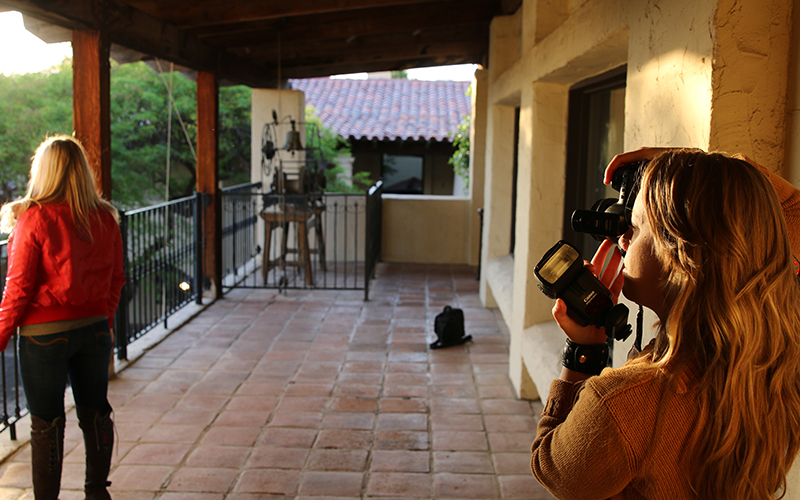
Schyler Anderson of Cave Creek has turned her hobby into a business. She often takes portraits of cosplayers. (Photo by Charlie Clark/Cronkite News)
Industry leads to offshoots
Schyler Anderson’s friends first introduced her to cosplay a few years ago. But dressing up in costume wasn’t quite her thing.
“Going to the conventions and seeing all the people in their costumes was really exciting for me, so I still wanted to be part of that, but not necessarily doing my own cosplays,” Anderson said.
Then it hit her. She could combine the experience with something else she loved: photography.
The 20-year-old Cave Creek resident began doing photo shoots with of one her best friends every time the friend finished a costume. Then she started doing it for others, and eventually, people approached her offering to pay her to do their shoots.
From there, she turned it into a photography business doing mostly weddings, portraits and cosplay.
Cosplay photoshoots have become increasingly popular not only for cosplay professionals, but also for hobbyists who just want a way to commemorate their creations.
“It is a mixture of many things,” said Catherine Ayotte, who cosplays under the name “zeldachann” and is a panelist at Phoenix Comicon. “It’s always nice to get photos of something you worked hard on.”
Anderson said she’s often booked nonstop on convention days, mostly by cosplayers who want to get photos of the costumes they’re debuting.
The market has grown so quickly, it has attracted an abundance of photographers, which can pose a challenge for cosplayers.
“It’s flooded the market with photographers, and it is a little difficult to know who you can trust,” said Samantha Kitts, a cosplayer and frequent convention panelist. The Tempe resident recently served as a panelist at Emerald City Comicon in Seattle.
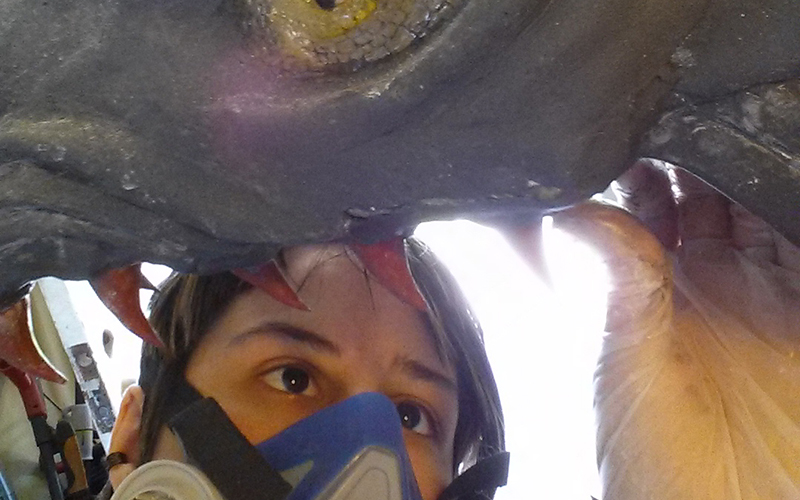
Tempe resident Lissa Carroll has spent three years and invested more than $1,000 on building a dragon head. (Photo courtesy of LIssa Carroll)
Cosplay allows for modern artistry
Tempe resident Lissa Carroll has spent three years and invested more than $1,000 on one project. She’s not quite done yet, but when her dragon head hits the convention floor, it promises to be a showstopper.
Carroll has been cosplaying since 2009, and she originally slapped together the dragon head a few years ago as a prop for cosplay she did with a friend.
In the beginning, she made it with a mix of paper mache and Crayola Magic Mold. But in the next iteration, she added lights to make the eyes glow and a hinge in the mouth, similar to a puppet. She also used a stronger mold.
Over the next few years, she continued to make the dragon more sophisticated and eventually wants to include animatronics and bring whole dragon, Alduin, from the video game “Skyrim,” to life.
“I’ve always been the kind of arts and crafts person,” Carroll said. “As I got older, certain events in my life shaped me, and I became a bit antisocial. Cosplay is my way of escaping that.
“It’s a way for me to bring forth all of my creative abilities, show them off and be accepted for it.”
Despite the commercial opportunity, many cosplayers say they don’t care about the money aspect. For them, it’s about having fun, socializing and artistry.
It can take a remarkable amount of skill and craftsmanship to sew, mold and smith things such as armor, weapons, helmets and dragon scales, and it often takes weeks or months of hard work.
Bennett Densmore started making costumes for Halloween, but after attending a convention in San Antonio, he was hooked.
When it comes to choosing characters, Densmore prefers difficult characters. And then there’s a height consideration. The Chandler resident stands at 6 feet 6 inches tall.
“If they’re tall, that’s a plus,” Densmore said. “I can’t do short characters. It looks too weird.”
Densmore’s cosplays, known on social media as Final Endeavour Cosplay, have picked up a following over the past few years. He has nearly 600 likes on Facebook, and he frequently receives inquiries about building props and costumes for other people.
But while Densmore occasionally builds weapons and props for others, he doesn’t build entire costumes or suits of armor, and he doesn’t have an interest in turning the opportunity into something more.
“I like to do it for fun,” Densmore said. “That is why I don’t want to make it a business. I just want to do this for fun.”
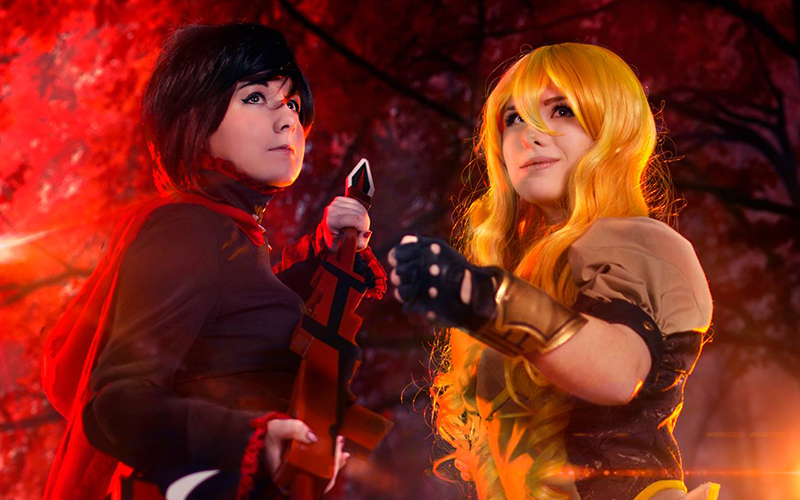
Catherine Ayotte (right) cosplays under the name “zeldachann.” She poses with Snow Habit, and they are cosplaying characters from the popular anime “RWBY.” (Photo by Tarasque Productions, courtesy of Catherine Ayotte)
Industry growth leads to criticism
The “fun first” attitude of cosplay is not necessarily universal.
“I don’t like when people shame other people’s cosplay, either for buying it or not looking perfect,” Densmore said. “If you didn’t have the funds or skills to make it, who cares?”
As the industry has grown, some participants say there’s more pressure to build elaborate costumes and a greater competitiveness. More simply, the universal friendliness and camaraderie that’s made cosplay so popular seems to have slipped a bit.
“It is different now from ‘09,” Carroll said. “When I started, it didn’t matter if I was a new beginner. It was all about helping each other. Now, it is more out for myself and a popularity contest.
“That spirit of goodwill has kind of been lost somewhere along the way.”
Ayotte, the Phoenix Comicon panelist, said you can break down cosplay into a few categories.
She said some do it for competition, to present for judges and try and improve their work. Others do it purely for the social element, interacting and enjoying parties. And then there are also the professionals.
It’s hard to pinpoint why there’s a growing sense of hierarchy – whether because of the professionalization and social media influences, the natural progression of having more “veterans” in this industry, or just the byproduct of making the jump into the mainstream.
Regardless, during more than a half dozen interviews with cosplayers, one concern kept coming up: elitism.
“Ninety-five percent are incredibly accepting, but there are some elitists cosplayers,” said Kitts, the recent Seattle convention panelist. “It’s supposed to be a creative medium, and it’s supposed to be fun. But there are some in the community that aren’t as kind.”
(Video by Charlie Clark/Cronkite News)
Cosplay also raises safety issues
Concerns for cosplayers go beyond elitism. At conventions, overly enthusiastic fans can overwhelm cosplayers, sometimes touching or or even sexually harassing them.
“There’s a misconception that I can come up and touch you,” Kitts said. “That is why cosplay is ‘not consent’ is so important. They get this expectation that we are a part of the show.”
Sexual harassment at conventions has been a concern for several years, and conventions have been increasingly responsive to calls for action, thus the “cosplay is not consent” movement has become a fixture slogan of most conventions.
Male and female cosplayers may dress in revealing clothing, and some attendees have taken that as a cue to take shady photos or even grope them. A recent – and recurring – example of this when convention goers make video montages of cosplayers’ butts and share them on YouTube.
Phoenix Comicon responded to the issue of potential sexual harassment early.
“We can’t take credit for starting the ‘cosplay is not consent,’ but we did incorporate the movement into our event as soon as we saw them start to post on social media,” said Boudrie, the program director. “We felt it was a great way to be proactive and help educate the community and public before any issue occurred.”
Cosplayers also have had to deal with being viewed as spectacles at conventions. There’s often a fine line between going to a convention and getting positive attention and being trapped for hours and expected to take photos.
Mitchel, who dresses as Superman and has been cosplaying since the early 2000s, described the treatment of cosplayers as similar to the way people treat mascots at Disney.
“You’re not a paid performer or part of the show,” Mitchel said. “It is becoming more of a trend as conventions grow.”
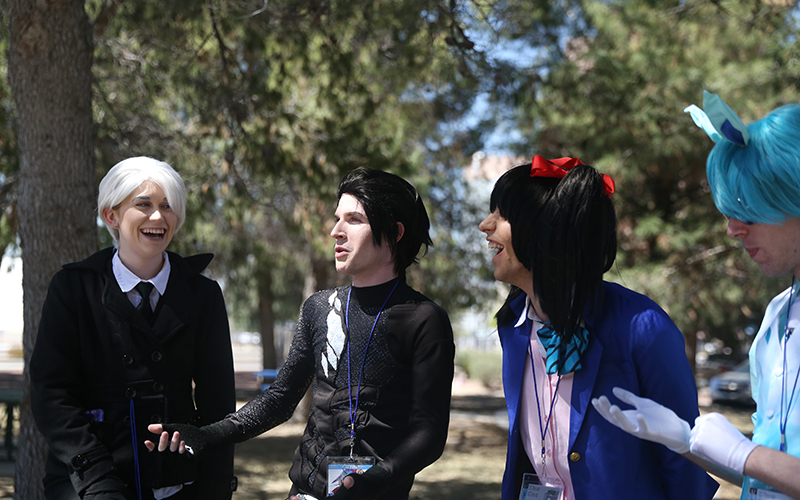
Marlee Suddarth, Ricky Billings, Matthew Allred and Brandon Kutchek met at various conventions and became friends through their love of cosplay. They attended Con Nichiwa in Tucson. (Photo by Megan Bridgeman/Cronkite News)
Players: Cosplay helps with self confidence
Despite concerns about the industry’s growth, those involved say the movement will only to continue to ensnare more fans because conventions are growing, and people are more accepting of “nerd culture” now.
And a brisk day in late March, local patrons to coffee shops, restaurants and bars in downtown Tucson likely saw this popularity firsthand.
People walked down the streets in cloaks, masks, weapons and body paint to attend Con Nichiwa at the Tucson Convention Center.
Marlee Suddarth, Ricky Billings, Matthew Allred and Brandon Kutchek had come out for the first day of the three-day convention.
The four said they met at various conventions and became friends through their love of cosplay.
“I feel like it helps people with their self confidence,” Suddarth said. “Outside in actual life, a lot of people are shy and awkward, but here everyone is real social. I feel it boosts a lot of social skills.”
That’s thing about cosplay, the thing that keeps people coming back for more.
Despite the frustrations with things like harassment or elitism, and aside from the creative joy and love of becoming a character, love of cosplay almost always comes back to the community.
Kitts said that being involved in the community helped her lose weight, more than 100 pounds.
“They didn’t care and something about that gave me confidence, so I stuck with it,” Kitts said.
And most importantly, participants say, it is a community about friendship.
“The people I meet is what keeps me coming back,” Ayotte said. “All of my friends are people I’ve met in conventions and cosplay. It’s more like a family than anything.”
